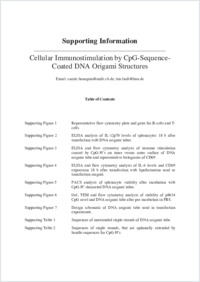Cellular immunostimulation by CpG-sequence-coated DNA origami structures
- Schüller, Verena J. Center for Nanoscience and Department of Physics, Ludwig-Maximilians-Universität, München, Germany
- Heidegger, Simon Abteilung für Klinische Pharmakologie, Medizinische Klinik, Klinik der Universität München, München, Germany
- Sandholzer, Nadja Abteilung für Klinische Pharmakologie, Medizinische Klinik, Klinik der Universität München, München, Germany
- Nickels, Philipp C. Center for Nanoscience and Department of Physics, Ludwig-Maximilians-Universität, München, Germany
- Suhartha, Nina A. Abteilung für Klinische Pharmakologie, Medizinische Klinik, Klinik der Universität München, München, Germany
- Endres, Stefan Abteilung für Klinische Pharmakologie, Medizinische Klinik, Klinik der Universität München, München, Germany
- Bourquin, Carole Abteilung für Klinische Pharmakologie, Medizinische Klinik, Klinik der Universität München, München, Germany - Chair of Pharmacology, Department of Medicine, University of Fribourg, Switzerland
- Liedl, Tim Center for Nanoscience and Department of Physics, Ludwig-Maximilians-Universität, München, Germany
-
17.11.2011
Published in:
- ACS Nano. - 2011, vol. 5, no. 12, p. 9696–9702
English
To investigate the potential of DNA origami constructs as programmable and noncytotoxic immunostimulants, we tested the immune responses induced by hollow 30-helix DNA origami tubes covered with up to 62 cytosine-phosphate-guanine (CpG) sequences in freshly isolated spleen cells. Unmethylated CpG sequences that are highly specific for bacterial DNA are recognized by a specialized receptor of the innate immune system localized in the endosome, the Toll-like receptor 9 (TLR9). When incubated with oligonucleotides containing CpGs, immune cells are stimulated through TLR9 to produce and secrete cytokine mediators such as interleukin-6 (IL-6) and interleukin-12p70 (IL-12p70), a process associated with the initiation of an immune response. In our studies, the DNA origami tube built from an 8634 nt long variant of the commonly used single-stranded DNA origami scaffold M13mp18 and 227 staple oligonucleotides decorated with 62 CpG-containing oligonucleotides triggered a strong immune response, characterized by cytokine production and immune cell activation, which was entirely dependent on TLR9 stimulation. Such decorated origami tubes also triggered higher immunostimulation than equal amounts of CpG oligonucleotides associated with a standard carrier system such as Lipofectamine. In the absence of CpG oligonucleotides, cytokine production induced by the origami tubes was low and was not related to TLR9 recognition. Fluorescent microscopy revealed localization of CpG-containing DNA origami structures in the endosome. The DNA constructs showed in contrast to Lipofectamine no detectable toxicity and did not affect the viability of splenocytes. We thus demonstrate that DNA origami constructs represent a delivery system for CpG oligonucleotides that is both efficient and nontoxic.
- Faculty
- Faculté des sciences et de médecine
- Department
- Département de Médecine
- Language
-
- English
- Classification
- Biological sciences
- License
- License undefined
- Identifiers
-
- RERO DOC 28468
- DOI 10.1021/nn203161y
- Persistent URL
- https://folia.unifr.ch/unifr/documents/302453
Statistics
Document views: 106
File downloads:
- bou_cis_sm.pdf: 507
